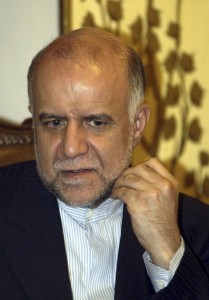
Iran’s new oil minister made an argument Sunday for lower oil prices, saying the high prices prevailing for the last three years make it economical for other countries to pump hard-to-get-at oil to supplant Iranian oil.
A week into the job, Oil Minister Bijan Namdar-Zanganeh told Shana, the Oil Ministry’s news service, that current prices of over $106 a barrel were a problem for Iran.
His comments represent a shift in stance from those of Iran’s previous oil minister who repeatedly said he wanted oil prices to remain above $100.
“The crude price increase to this level represents both opportunity and threat,” Zanganeh said. “It is an opportunity for us to increase our revenues, [but] high oil prices also represent a threat for our country, because our rivals can produce oil at high production cost and supply it to the market [at a profit].”
The high crude price has helped spur a surge in production of relatively costly shale oil in North America. If the oil price were half what it is now, such oil would be far too expensive to pump.
The production surge has helped swell global oil supplies, enabling Washington to tighten restrictions on Iranian oil exports without causing a price spike that might threaten global growth.
Zanganeh said, “Today, the US is investing mainly in shale gas and shale oil production…. At these prices, shale gas and shale oil production is economical for them.”
While he appeared to be saying lower prices would be good for Iran, he didn’t give any numbers. There was no indication by him as to what price would drive the shale oil off the market without pinching Iran.
Zanganeh said he was optimistic that the new Iranian government could revive Iran’s oil exports, which are now running at 45 percent the volume that prevailed for 20 years through 2011.
“Given the present circumstances, we are facing myriad challenges to exports, but we have to try our best to increase oil exports,” he told Shana. “Despite challenges we are facing, Iran’s oil exports will increase in the near future.” He didn’t say how he would do that.
Iran’s oil exports have fallen 1.4 million barrels a day under US and EU sanctions. US oil output alone has increased by 1 million barrels a day in that time frame and rising output in Canada and elsewhere has more than made up for the loss of Iranian crude.
Even with oil hovering above $100, however, Tehran has found it impossible to balance its budget as export volumes have plunged. The US government estimates that Iran’s oil revenues fell from $95 billion in 2011 to $69 billion in 2012. It isn’t yet producing an estimate for 2013.
What also remains unclear is why Iran’s budget is under such strain. The chart at the bottom of the page shows the average price of an OPEC barrel for the last several years. The price has only been above $100 the last three years (including 2013).
Yet the price never even reached $50 a barrel until 2005, the year Ahmadi-nejad took office. President Khatami managed to balance the budget with oil revenues far less than they are today, suggesting the budget problem is not so much a revenue crisis as a crunch from spendthrift policies in recent years.
